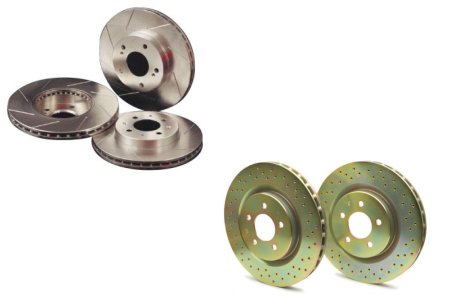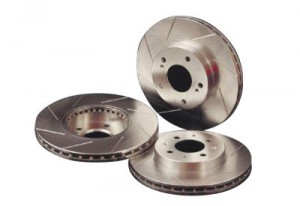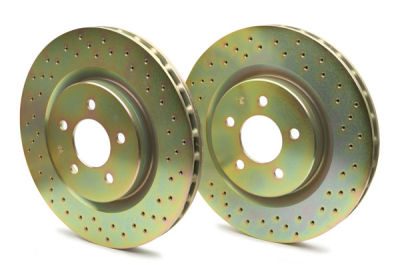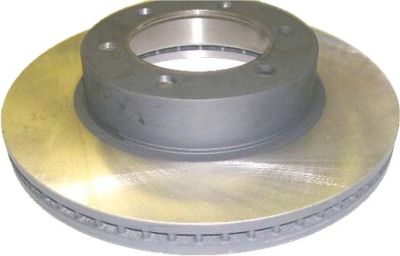Slotted Cross-Drilled Rotors For Trucks and Towing – Part One
Jason Lancaster | Feb 09, 2009 | Comments 1
FACT: The brakes that were installed on your truck at the factory are a compromise between cost, performance, durability, and noise. While they do an excellent job of stopping your truck (even when there’s a big load being towed behind), they are far from the best option available to you. While there are some trade-offs, buying an after-market set of brake rotors can boost your truck’s braking performance (especially while towing and hauling).

In a nut-shell, most modern trucks (or trucks with disc brakes) have two main brake components – rotors and pads. Rotors are the large, flat rotating mass that are attached to your wheel hubs. Brake pads press up against the rotors in order to generate the friction necessary to stop your vehicle. Simple enough, right?
Stock, or OEM, rotors are usually completely flat, solid, and smooth. This is the cheapest and strongest configuration for a brake rotor, but it’s certainly not the best.Braking systems can get very hot during normal use, and when they get too hot, performance starts to suffer. This reduced performance due to heat is known as “brake fade,” and it’s quite common during towing.
- Overheated brake pads don’t generate as much friction as they normally would, increasing braking distance and reducing responsiveness.
- Overheated pads wear prematurely and cost you money.
- Overheated rotors tend to “cook” accumulated brake dust onto the surface of the rotor. This creates a noticeable “wobble” that’s felt while braking. This “wobble” is colloquially known as a “warped rotor,” but in reality it’s simply an uneven accumulation of brake pad material on the rotor surface.
- This wobble reduces brake effectiveness, wears pads prematurely, and it’s not terribly comfortable to drive while braking (especially during hard braking).
When brakes overheat, performance and durability suffer. Therefore, it’s important to keep your brakes cool. Most factory brake systems use a simple, solid piece design, and this design doesn’t have a lot of places for heat to escape.
So, if you want to improve the durability and performance of your truck’s factory braking system, there are four main rotor designs to consider:

These slotted rotors are offered by Power Slot.
- Slotted Rotors. Slotted rotors, such as those available from Power Slot, have channels carved into the flat surfaces of the rotor at specific angles. These channels are largely meant to direct outside air towards the rotor and the pad in order to provide extra cooling. This cooling effect reduces brake fade, brake pad wear, and reduces the likelihood of “cooking” brake pad material onto the rotor surface. The slots have one more benefit as well – as brake pads rub up against the rotors, dust can collect on the rotor. Slotted rotors reduce accumulating brake dust (and improve performance).

Brembo offers a wide selection of cross-drilled rotors for almost all vehicles, even big pickups.
- Drilled or “cross-drilled” rotors. Drilled rotors, like the ones offered by popular brake manufacturer Brembo, are designed with much the same philosophy as slotted rotors. The main difference is that drilled rotors have holes drilled through them in special patterns. These patterns are aerodynamically designed to force air through the rotor, cooling it considerably. They also reduce the amount of brake dust that “sits” on the rotor (improving performance).
- Slotted AND drilled rotors. Slotted and drilled rotors combine both features described above (and are not shown here).
The Toyota Tundra features stock ventilated rotors. Notice the “sandwich” of cast iron behind the machined rotor surface. The gaps between the cast iron boost surface area and enhance cooling.
- Vented or ventilated rotors. Ventilated rotors aren’t one big solid hunk of cast iron (which is the basic rotor design found on many new vehicles). Instead, some of the iron behind the rotor surfaces is removed to create “vents.” These vents increase the surface area of the rotors and boost cooling. Many quality factory braking systems, including those on the 2007 and up Tundra, feature ventilated rotors, as do all quality after-market rotors.
We know that vented rotors are the real deal (Toyota offers them on the new Tundra), but in part two we’ll discuss “Do these drilled and slotted rotors really work, or are they just a gimmick?“
Filed Under: Toyota Tundra Accessories



[…] see if it helps. BTW the slotted disc help to dossiapte the heat and keep your rotors from warping. Slotted-Cross Drilled Rotors For Trucks and Towing – Part One | Tundra Headquarters __________________ MIDNIGHT RIDER CREWMAX LIMITED AVS Bug Shield AFE CAI Stage II Borla Pro XS […]